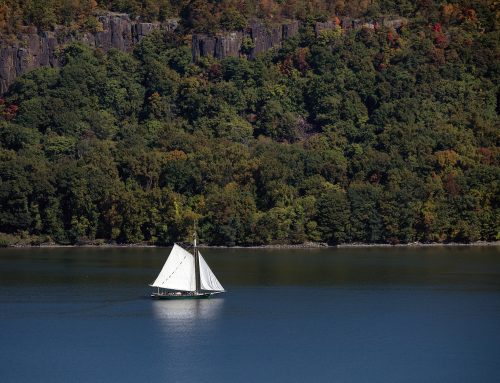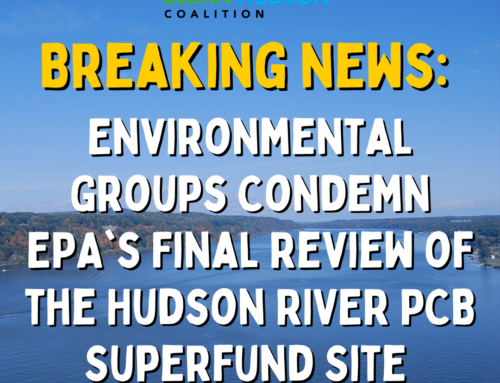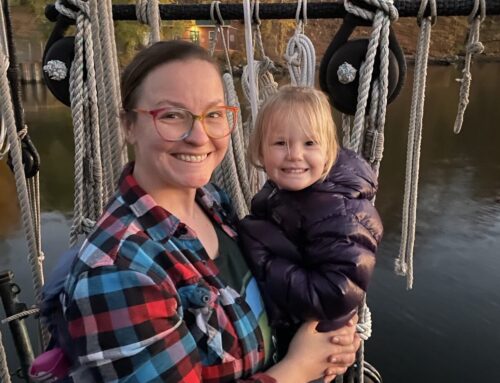Hudson Valley, N.Y. – Riverkeeper, Clearwater and Scenic Hudson are demanding immediate action from federal authorities in response to revelations of flawed fish data and premature dismantling of equipment used in the historic Hudson River PCBs cleanup project – problems that threaten to undermine the entire effort.
The three organizations sent a letter Thursday, September 3, to Judith Enck, Region 2 Administrator for the U.S. Environmental Protection Agency, calling on the agency in charge of the Hudson River PCB cleanup to confront fundamental missteps that threaten to undermine any claim of success for this historic cleanup effort.
The letter demands that EPA investigate General Electric’s inaccurate and possibly falsified underreporting of PCB levels in fish, and its use of a “rib out” testing method that yielded artificially low numbers. This data problem comes on the heels of a recent analysis by a federal Natural Resource Damages trustee which found that the amount of PCBs in the upper Hudson River was underestimated by a factor of 2 to 3 times, and that GE also grossly overestimated the rate of natural breakdown of PCBs. The new information points to a real risk that remedial decisions made in the past, and even in the future, could be undermined.
“Nothing less than the river’s health and the health of our local economies are at stake here,” Riverkeeper President Paul Gallay said. “We will not let GE’s malfeasance or government inaction deprive us of the cleanup we deserve to see. GE must immediately take responsibility to reverse the damage it has done, and our state and federal agencies must honor their obligation to represent the public’s interest.”
The groups seek the following:
- EPA must investigate General Electric’s failure to follow protocol in its sampling of PCB concentration in fish, and its apparent filing of false certifications for the data. EPA must hold the company fully responsible for any violations of laws, regulations and orders.
- EPA must immediately halt the dismantling of the state-of-the-art dredging systems, dewatering facility and other vital equipment in the Hudson River PCBs cleanup.
- Because the entire Superfund cleanup relies on accurate monitoring of PCB levels in the fish, EPA must begin a new “Five Year Review” to analyze whether the remedy is actually protective of human health and the environment, as previously claimed.
“While General Electric (and EPA) may want to put this matter behind them, they cannot be allowed to get away with only a partial cleanup,” said Peter Gross, Executive Director of Hudson River Sloop Clearwater. “The Hudson River deserves a truly comprehensive remediation. Too many people still eat Hudson River fish, despite New York State Department of Health advisories warning against fish consumption. That makes this not only an environmental issue, but also an environmental justice and public health problem. Without more dredging the recovery will be greatly delayed. The more comprehensive the cleanup – as called for by the Federal Trustees – the sooner the River will recover and this danger will be resolved – and then we can all put this behind us, knowing the job is complete.”
Scenic Hudson President Ned Sullivan said, “EPA has allowed its partial remediation of the Hudson to be a foil for a comprehensive cleanup of our American Heritage River. Now EPA is allowing GE to dismantle its cleanup facilities without following the protocol and consultative process required by its own consent order. The improper sampling procedure GE has employed raises serious questions about the integrity of the cleanup and EPA conclusions about the adequacy of the project. EPA must immediately halt the decommissioning of the cleanup facilities and initiate a comprehensive review of the adequacy of the remedial action.”
Background:
For the past six years, GE has been dredging PCB-contaminated sediments from the Hudson pursuant to an EPA-mandated cleanup plan. This plan, however, excludes a number of toxic hotspots, described by other federal agencies as the “equivalent of a series of Superfund-caliber sites.” Expanded dredging beyond the current plan is necessary to remove these toxic sediments.
GE is now beginning what it says is its final season of the cleanup, but has not announced any plans to address this remaining pollution. Beyond the current cleanup, the company has substantial legal obligations under the Natural Resource Damages (NRD) liability. NRD awards are intended to cover the costs to restore a damaged resource after an EPA cleanup as well as compensate the public for the loss of use of the resource while it was contaminated.
More than 80 municipalities, 181 members of the New York State Assembly, 25 members of the New York State Senate, GE institutional shareholders, boat and yacht club organizations, and hundreds of individual members of the public have called upon GE to continue its dredging operations and to use its current facilities and infrastructure to complete this additional work.
In the coming months, GE, the NRD Trustees, the EPA and other key players must come to an agreement to finish the job the right way in order to protect New Yorkers and restore this treasured resource.
###
Press Contacts:
Toni Martin, Hudson River Sloop Clearwater, toni@clearwater.org, (845) 265-8080, x7112
Leah Rae, Riverkeeper, lrae@riverkeeper.org, (914) 478-4501 ext. 238 or (914) 715-6821
Jay Burgess, Scenic Hudson, jburgess@scenichudson.org, (845) 473-4440, Ext. 222





